Graduate Aptitude Test in Engineering 2017
Question Paper Name: Petroleum Engineering 5th Feb 2017
Subject Name: Petroleum Engineering
Duration : 180
Total Marks: 100
1. If a vector ![]() has components vx = 1, vy = 2, vz = 3, then its magnitude is ______. (write answer with two decimal places)
has components vx = 1, vy = 2, vz = 3, then its magnitude is ______. (write answer with two decimal places)
Ans: (3.70 to 3.79)
2. The value of ![]() is _____.
is _____.
3. If  is to be solved using the conditions y(0) = and y(1) = b, which of the following numerical method(s) can be used?
is to be solved using the conditions y(0) = and y(1) = b, which of the following numerical method(s) can be used?
(A) Euler with shooting method
(B) Euler without shooting method
(C) 4th order Runge-Kutta with shooting method
(D) Both (A) and (C)
Ans: (D)
4. The numerical method used to find the root of a non-linear algebraic equation, that converges quadratically, is :
(A) Bisection method.
(B) Regula-falsi method (Method of False Position).
(C) Newton-Raphson method.
(D) None of the above
Ans: (C)
5. Which one of the following curves shows a typical behavior of the producing gas oil ratio (GOR) with time for a reservoir under solution gas drive?
(A) 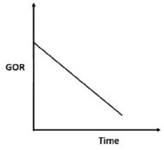
(B) 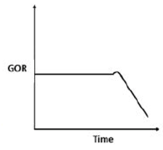
(C) 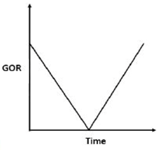
(D) 
Ans: (D)
6. A student has written following possible causes of lost circulation during a drilling operation.
i. High salinity in the reservoir
ii. Fracture in the reservoir
iii. A fault encountered during drilling
iv. Low viscosity of the reservoir fluid
Which of the above statements are correct?
(A) i, iv
(B) ii, iii
(C) i, iii
(D) ii, iv
Ans: (B)
7. For water depth less than 8 m, which one of the following drilling vessels is the most suitable and economical?
(A) Semi-submersible rig
(B) Jack-up rig
(C) Drilling barges
(D) Drill ship
Ans: (C)
8. Which one of the following statements is correct for pseudo-steady state condition in a confined reservoir?
(A) The pressure decline stops in the reservoir.
(B) The pressure declines at the same rate across the reservoir.
(C) The boundary pressure does not change.
(D) The pressure starts increasing in the reservoir.
Ans: (B)
9. The roots of the equation  are :
are :
(A) 1, 1, 2
(B) 1, 2, 3
(C) 1, 3, 4
(D) 1, 2, 4
Ans: (B)
10. The °API of a crude oil density 950 kg/m3 is ______.(write answer with two decimal places)
Ans: (17.00 to 18.00)
11. The differential equation 2xydx + (1 + x2)dy = 0, in which x is an independent variable and y is the dependent variable, is :
(A) an ordinary differential equation of second order.
(B) a first order nonlinear differential equation.
(C) an exact differential equation.
(D) a partial differential equation.
Ans: (C)
12. For the two marices  , the product YX will be:
, the product YX will be:
(A) ![]()
(B) ![]()
(C) ![]()
(D) ![]()
Ans: (A)
13. As per the Bharat IV norms, the maximum permissible limit of sulfur in diesel in ppm is :
(A) 10
(B) 50
(C) 100
(D) 500
Ans: (B)
14. The amount of methane gas evolved at 0℃ and 1 atm from the dissociation of 1 m3 of methane gas hydrate, is approximately:
(A) equal to the volume of gas hydrate.
(B) 10 times the volume of gas hydrate.
(C) 160 times the volume of gas hydrate.
(D) 300 times the volume of gas hydrates.
Ans: (C)
15. For a centrifugal pump, the head developed by the pump is proportional to the :
(A) speed of the impeller rotation.
(B) square of speed of the impeller rotation.
(C) cubic power of speed of the impeller rotation.
(D) square root of speed of the impeller rotation.
Ans: (B)
16. Which of these is a must for petroleum generation and accumulation?
(A) Source rocks
(B) Porous reservoir rocks
(C) Impermeable cap rocks
(D) All of the above
Ans: (D)
17. The problem of viscous fingering is encountered when:
(A) a low viscosity fluid is injected in a high viscosity fluid.
(B) a high viscosity fluid is injected in a low viscosity fluid.
(C) a fluid of equal viscosity but lower density is injected in a fluid of higher density.
(D) none of the above
Ans: (A)
18. Which of these is NOT a sedimentary rock?
(A) Shale
(B) Sandstone
(C) Carbonate
(D) None of the above
Ans: (D)
19. The unbiased sample variance for the set of numbers: S={40, 45, 50, 55, 60} is ______.(write answer with one decimal place
Ans: (61.0 to 63.0)
20. If 5x + 2iy – ix + 7y = 2 + 3i, where ![]() the values of two real numbers (x, y) are, respectively:
the values of two real numbers (x, y) are, respectively:
(A) (−1, 1)
(B) (1, −1)
(C) (1, 1)
(D) (−1, −1)
Ans: (A)
21. Pick the INCORRECT inequality, where z1, z2 and z3 are complex numbers.
(A) |z1 + z2| ≤ |z1| + |z2|
(B) |z1 − z2| ≥ |z1| − |z2|
(C) |z1 − z2| ≤ |z1| − |z2|
(D) |z1 + z2 + z3 | ≤ |z1| + |z2| + |z3|
Ans: (C)
22. Which of the following is NOT true? ![]()
(A) 
(B) ![]()
(C) 
(D) 
Ans: (D)
23. Which of the following is a potential environmental threat due to the cement-plug deterioration in an abandoned oil well?
(A) Well bore could leak oil reservoir fluids into groundwater
(B) Oil reservoir fluids could flow to the surface and contaminate surface soil
(C) Oil reservoir fluids could discharge into navigable waters
(D) All of the above
Ans: (D)
24. _______ is a mode of flame propagation in a pre-mixed gas, and drives a leading shock front into the quiescent, unburnt gas at supersonic velocity, immediately followed by a combustion zone.
(A) Deflagration
(B) Fire
(C) Detonation
(D) Ignition
Ans: (C)
25. Bio-Ga(BG), Coal Bed Methane (CBM) and Methane Gas Hydrate (MGH), if arranged in the order of increasing methane content, the correct order is :
(A) BG, CBM, MGH
(B) CBM, BG, MGH
(C) CBM, MGH, BG
(D) BG, MGH, CBM
Ans: (A)
26. For a velocity field given by ![]() calculate the curl of
calculate the curl of ![]() If the calculated vector is
If the calculated vector is ![]() then the value of c is _______
then the value of c is _______
Ans: (−2.05 to −1.95)
27. Single step integration (step size = 0.5) of  evaluated numerically using the Simpson’s 1/3 rule, is _______(write answer with three decimal places)
evaluated numerically using the Simpson’s 1/3 rule, is _______(write answer with three decimal places)
Ans: (0.720 to 0.730)
28. Solve ![]() numerically from x = 0 to 1 using explicit, forward, first order Euler method with initial condition of y(0) = 1 and step size (h) of 0.2. The absolute value of error in y(1) calculated using analytical and numerical solution is _____% (calculate the error using analytical solution as the basis and use three decimal places)
numerically from x = 0 to 1 using explicit, forward, first order Euler method with initial condition of y(0) = 1 and step size (h) of 0.2. The absolute value of error in y(1) calculated using analytical and numerical solution is _____% (calculate the error using analytical solution as the basis and use three decimal places)
Ans: (10.5 to 11.5)
29. Relative permeability curves are shown in the following figure for a water-oil system in a porous medium. Sw is water saturation and kr is relative permeability. Curve 1 is relative permeability of water and Curve 2 is relative permeability of oil. Assuming the porous medium is at irreducible water saturation initially, the maximum possible recovery of oil by water flooding is _____%. (write answer with one decimal place)

Ans: (72.0 to 75.0)
30. An oil reservoir of 1000 m2 area and thickness of 10 m has a porosity of 30%. The connate water saturation is 20%. Initial formation volume factor  Assuming average oil flow rate of 2 m3/day (at surface condition), the life of reservoir is _____ days.
Assuming average oil flow rate of 2 m3/day (at surface condition), the life of reservoir is _____ days.
Ans: (999.0 to 1001.0)
31. A self-flowing production well of depth 3,000 m having oil with density 850 kg/m3 is shut-in for workover job. The shut-in pressure at the surface is 70 × 105 N/m2. The density of the mud required to kill the well will be _____kg/m3. (G = 9.81 m/s2, write answer with one decimal place)
Ans: (1080.0 to 1095.0)
32. In a directional well, the kick off point has a true vertical depth (TVD) of 1000 m and the end of buildup section has a TVD of 1200 m. The buildup section for directional drilling has a horizontal displacement of 200 m, after which the tangent section has inclination of 45°. A driller monitors the well from the surface location of the well and sees that the target has horizontal departure of 1000 m. The T VD of the deepest point of the well is _____meters.
Ans: (1990 to 2010)
33. The figure below shows the pressure measured in a well at different depths. AB is cap, B is gas oil contact and C is water-oil contact. Density of gas in gas cap is 2 kg/m3, oil density is 800 kg/m3 and water density is 1000 kg/m3. The difference between pressure at point D and point B (PD – PB) is _____× 105 N/m2. (use g = 9.81 m/s2, write answer with one decimal place)
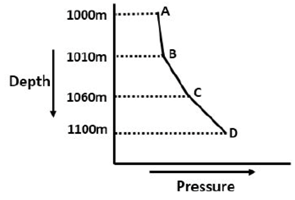
Ans: (7.5 to 8.2)
34. A laboratory air-brine capillary pressure of 1.20 × 105 N/m2 has been measured in a reservoir core sample at residual water saturation. The air-brine surface tension is 0.070 N/m, and the brine-oil interfacial tension for the reservoir fluid is 0.025 N/m. The density values of brine and oil are 1080 kg/m3 and 780 kg/m3, respectively. Take g = 9.81 m/s2, and assume identical wetting preferences for the core sample and reservoir. The height of the water-oil transition zone (up to the point of reservoir where connate water saturation is reached) from the free water level is ____meters. (write answer with two decimal places)
Ans: (14.20 to 14.90)
35. The eigenvalues for the matrix  are :
are :
(A) 2 and 5
(B) −2 and −5
(C) −2 and 5
(D) none of the above
Ans: (C)
36. The temperature time profile for a system is given as follows: ![]() where T is temperature in ℃, and t is time in hours. The initial conditions are T(0) = 500℃. The temperature of the system after 1 hour is _____℃. (write answer with two decimal places)
where T is temperature in ℃, and t is time in hours. The initial conditions are T(0) = 500℃. The temperature of the system after 1 hour is _____℃. (write answer with two decimal places)
Ans: (101.00 to 104.00)
37. A porous medium is blended with three types of sediment fractions, fine pebble gravel with porosity (ϕpebble = 38%), sand (ϕsand = 32%) and fine sand(ϕfine_sand = 30%). The three sediments are mixed in such proportions that the sand fills the pore volume of fine pebbles completely, and the fine sand fills the pore volume of sand completely. The total porosity of such an irregular system is ______%. (write answer with two decimal places)
Ans: (3.50 to 3.80)
38. Match the following
(P) Sandstone (I) Clastic rocks
(Q) Limestone (II) Noncalstic rocks
(R) Shale
(S) Gypsum
(A) P-I, Q-I, R-II, S-II
(B) P-II, Q-II, R-I, S-I
(C) P-I, Q-II, R-I, S-II
(D) P-II, Q-I, R-II, S-I
Ans: (C)
39. Oil of density 900 lg/m3 is flowing at 100 m3/day through a horizontal pipeline having a diameter reduction from 0.1 m to 0.05 m as shown in the following figure. The kinetic energy pressure drop (P1 – P2) caused by the diameter change is _____N/m2. (Assume frictional losses to e negligible, write answer with one decimal place)
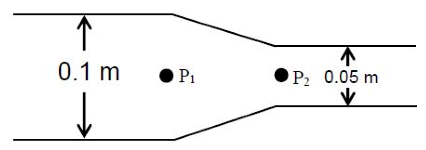
Ans: (140.0 to 150.0)
40. Match the following EOR techniques and the principle behind them:
(P) Surfactant flooding
(Q) Polymer flooding
(R) Steam flooding
(S) Sea water flooding
(I) Lower the viscosity of the oil phase
(II) Increase the viscosity of the aqueous phase
(III) Lower the oil-water interfacial tension
(IV) Influence the wettability of the rock
(A) P-I, Q-II, R-III, S-IV
(B) P-II, Q-III, R-IV, S-I
(C) P-III, Q-II, R-I, S-IV
(D) P-III, Q-I, R-II, S-IV
Ans: (C)
41. The viscosity – shear rate curve for a fluid is shown in the following plot. Which one of the following options best describes the behavior of the fluid in the regions I, II, and III, respectively?

(A) Newtonian, Shear thinning, Shear thickening
(B) Shear thinning, Newtonian, Shear thickening
(C) Shear thickening, Newtonian, Shear thinning
(D) Shear thinning, Shear thickening, Newtonian
Ans: (B)
42. The value of constant a for which :  is a valid probability density function, is (given, a ≥ 0):
is a valid probability density function, is (given, a ≥ 0):
(A) ![]()
(B) ![]()
(C) ![]()
(D) ![]()
Ans: (B)
43.  where ,
where , ![]() would simplify to:
would simplify to:
(A) 1 – i
(B) 1
(C) −i
(D) 1 + i
Ans: (D)
44. A well of radius 0.25 m is drilled. Mud invasion in the formation caused a skin radius of 2 m and reduced the permeability of the damaged zone to 30 mD. Well test revealed that the skin factor of the damaged zone is 2.3. The permeability of the unaffected formation will be ______mD. (write answer the one decimal place)
Ans: (60.0 to 65.0)
45. The average reservoir pressure and fracture gradient of petroleum formation at a depth of 4,000 m are 30,000 kN/m2 and 16(kN/m2)/m, respectively. The density of the formation is 2290 kg/m3. If the reservoir pressure declines to 20,000 kN/m2 after a few years of production, the fracture gradient of the formation is ____(kN/m2)/m. (write answer with one decimal place)
Ans: (13.5 to 15.5)
46. Match the following:
(P) Gamma ray log (I) Water saturation
(Q) Resistivity log (II) Acoustic waves
(R) Cement bond log (III) Permeability
(S) NMR log (IV) Lithology
(A) P-IV, Q-I, R-II, S-III
(B) P-I, Q-II, R-III, S-IV
(C) P-I, Q-III, R-II, S-IV
(D) P-IV, Q-II, R-I, S-III
Ans: (A)
47. The sonic log travel time in a loosely consolidated formation is 260 μs/m. The matrix and fluid travel times are 130 μs/m and 618 μs/m, respectively. A correction factor of 1.0 may be used in a Wyllie time average equation for simplification. The calculated formation porosity using the Wyllie time average equation is _____%. (write answer with two decimal places)
Ans: (25.00 to 28.00)
48. An oil emulsion having 15% water cut by weight is being treated in a horizontal heater-treater unit at the rate of 6000 kg/hr. The inlet temperature of the emulsion is 30℃ and operating temperature of the heater-treater is 40℃. The specific heat capacity of water and oil are 1 kcal/kg℃ and 0.5 kcal/kg℃, respectively. Assuming 10% of the total heat input is lost to the surroundings, the total heat energy required to break the emulsion in the heater-treater unit is ______kcal/hr. (write answer with one decimal place)
Ans: (38200.0 to 38500.0)
49. An oil well has a flowing bottom hole pressure of 3000 psi and the reservoir has an average pressure of 3250 psi. A pressure build-up test reveals that the slope of the straight line portion of Horner’s plot is 38.5 psi/cycle and skin factor of the well is 3. The flow efficiency of this well is _____. (write answer with two decimal places)
Ans: (0.55 to 0.65)
50. A pressure charged, casing pressure operated gas lift valve is installed at a depth of 200 m and the bellow pressure of this valve is 50 × 105 N/m2 under operating conditions. The tubing pressure is 30 × 105 N/m2 at the valve depth. The area of the bellow and the port are 6 and 0.6 cm2, respectively. The opening pressure of the gas lift valve under operating conditions is ______× 105 N/m2. (Write answer with one decimal place)
Ans: (50.0 to 54.0)
51. Match the following:
(P) Coal bed methane
(Q) Tight gas
(R) Gas hydrate
(S) Associated gas
(I) Requires natural or artificial fractures
(II) Exists in solid phase
(III) Gas absorbed on surface in micro-pores
(IV) Dissolved in crude oil
(A) P-I, Q-II, R-III, S-IV
(B) P-IV, Q-III, R-I, S-II
(C) P-III, Q-I, R-II, S-IV
(D) P-IV, Q-I, R-II, S-III
Ans: (C)
52. Match the following in the context of treatment of oil spills:
(P) Boom
(Q) Absorbent
(R) Skimmer
(S) Biostimulation
(I) Use of chemical fertilizers to enhance the rate of oil degradation by microbes
(II) Mechanized equipment for removing floating oil from water surface
(III) Floating physical barrier to divert oil to a recovery area
(IV) Oleophilic material to attract oil, which can be removed subsequently
(A) P-I, Q-IV, R-II, S-III
(B) P-III, Q-IV, R-II, S-I
(C) P-III, Q-II, R-IV, S-I
(D) P-I, Q-III, R-IV, S-II
Ans: (B)
53. Match the following:
(P) Aquifer
(Q) Aquitard
(R) Aquicludes
(I) Slows down the movement of water and not good for water (or CO2) injection
(II) Evaporite rocks, such as halide or anhydrite, retarding upward movement of water/CO2
(III) Prefrentially stores CO2 but not water
(IV) Rocks with sufficient permeability to conduct water, into which water (or CO2) may be injected
(A) P-I, Q-III, R-IV
(B) P-IV, Q-I, R-III
(C) P-IV, Q-I, R-II
(D) P-IV, Q-II, R-III
Ans: (C)
54. Synthetic Aperture Radar (SAR), used for oil spill monitoring and detection, is based on the:
(A) dampening effect oil has on capillary and short ocean surface waves, as seen in the radar backscatter signal.
(B) radar backscatter signal only from navigating ships.
(C) frequency change in the radar backscatter signal from flights over the sea.
(D) physical sample collection from random locations on the high seas.
Ans: (A)
55. The adjacent figure shows the phase diagram of free methane gas and methane hydrate for a pure water and pure methane system. Match the zone marked (I), (II), (III) and (IV) with different states of phases listed below.
(P) Methane hydrate + water + gas
(Q) Methane gas + water
(R) Methane gas + ice
(S) Methane hydrae + ice + gas

(A) I-R, II-S, III-P, IV-Q
(B) I-R, II-Q, III-P, IV-S
(C) I-R, II-S, III-Q, IV-P
(D) I-R, II-P, III-S, IV-Q
Ans: (C)
56. The ninth and the tenth of this month are Monday and Tuesday _______.
(A) figuratively
(B) retrospectively
(C) respectively
(D) rightfully
Ans: (C)
57. It is _______ to read this year’s textbook ______ the last year’s
(A) easier, than
(B) most easy, than
(C) easier, from
(D) easiest, from
Ans: (A)
58. A rule states that in order to drink beer, one must be over 18 years old. In a bar, there are 4 people. P is 16 years old, Q is 25 years old, R is drinking milkshake and S is drinking a beer. What must be checked to ensure that the rule is being followed?
(A) Only P’s drink
(B) Only P’s drink and S’s age
(C) Only S’s age
(D) Only P’s drink, Q’s drink and S’s age
Ans: (B)
59. Fatima starts from point P, goes North for 3 km, and then East for 4 km to reach point Q. She then turns to face point P and goes 15 km in that direction. She then goes North for 6 km. How far is she from point P, and in which direction should she go to reach point P?
(A) 8 km, East
(B) 12 km, North
(C) 6 km, East
(D) 10 km, North
Ans: (A)
60. 500 students are taking one or more courses out of Chemistry, Physics and Mathematics. Registration records indicate course enrolment as follows: Chemistry (329), Physics (186), Mathematics (295), Chemistry and Physics (83), Chemistry and Mathematics (217), and Physics and Mathematics (63). How many students are taking all 3 subjects?
(A) 37
(B) 43
(C) 147
(D) 53
Ans: (D)
61. “If you are looking for a history of India, or for an account of the rise and fall of the British Raj, or for the reason of the cleaving of the subcontinent into two mutually antagonistic parts and the effects this mutilation will have in the respective sections, and ultimately on Asia, you will not find it in these pages; for though I have spent a lifetime in the country. I lived too near the seat of events, and was too intimately associated with the actors, to get the perspective needed for the impartial recording of these matters.”
Which of the following statements best reflects the author’s opinion?
(A) An intimate association does not allow for the necessary perspective.
(B) Matters are recorded with an impartial perspective.
(C) An intimate association offers an impartial perspective.
(D) Actors are typically associated with the impartial recording of matters.
Ans: (A)
62. Each of P, Q, R, S, W, X, Y and Z has been married at most once. X and Y are married and have two children P and Q. Z is the grandfather of the daughter S of P. Further, Z and W are married and are parents of R. Which one of the following must necessarily be FALSE?
(A) X is the mother-in-law of R
(B) P and R are not married to each other
(C) P is a son of X and Y
(D) Q cannot be married to R
Ans: (D)
63. 1200 men and 500 women can build a bridge in 2 weeks. 900 men and 250 women will take 3 weeks to build the same bridge. How many men will be needed to build the bridge in one week?
(A) 3000
(B) 3300
(C) 3600
(D) 3900
Ans: (C)
64. The number of 3-digit numbers such that the digit 1 is never to the immediate right of 2 is
(A) 781
(B) 791
(C) 881
(D) 891
Ans: (C)
65. A contour line joins locations having the same height above the mean sea level. The following is a contour plot of geographical region. Contour lines are shown at 25 m intervals in this plot.
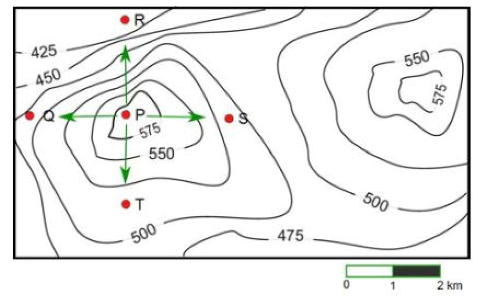
Which of the following is the steepest path leaving from P?
(A) P to Q
(B) P to R
(C) P to S
(D) P to T
Ans: (B)
Latest Govt Job & Exam Updates: